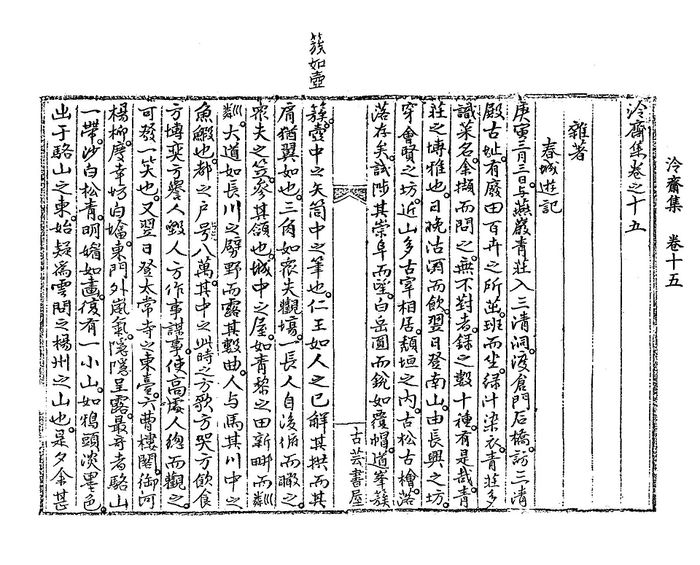(Translation) 柳得恭 春城遊記
| Primary Source | ||
|---|---|---|
 |
Title | |
| English | ||
| Chinese | 春城遊記 | |
| Korean(RR) | 춘성유기(Chun-seong-yu-gi) | |
| Text Details | ||
| Genre | Literati Writings | |
| Type | ||
| Author(s) | 柳得恭(Yoo Deukgong) | |
| Year | 1770 | |
| Source | ||
| Key Concepts | Spring Excursion, Hanyang Castle | |
| Translation Info | ||
| Translator(s) | Participants of 2018 Summer Hanmun Workshop (Advanced Translation Group) | |
| Editor(s) | ||
| Year | 2018 | |
목차
- 1 Introduction
- 2 Original Script
- 3 Discussion Questions
- 4 Further Readings
- 5 Translation
- 5.1 (sample) : Jaeyoon Song
- 5.2 Student 1 : (Write your name)
- 5.3 Student 2 : (Write your name)
- 5.4 Student 3 : (Write your name)
- 5.5 Student 4 : (Write your name)
- 5.6 Student 5 : (Write your name)
- 5.7 Student 6 : (Write your name)
- 5.8 Student 7 : (Write your name)
- 5.9 Student 8 : (Write your name)
- 5.10 Student 9 : (Write your name)
- 5.11 Student 10 : (Write your name)
- 5.12 Student 11 : (Write your name)
- 5.13 Student 12 : (Write your name)
- 5.14 Student 13 : (Write your name)
- 5.15 Student 14 : (Write your name)
Introduction
Original Script
| Classical Chinese | English |
|---|---|
|
庚寅三月三日。與燕巖靑莊入三淸洞。渡倉門石橋。訪三淸殿古址。有廢田百卉之所茁。班而坐。綠汁染衣。靑莊多識菜名。余擷而問之。無不對者。錄之數十種。有是哉。靑莊之博雅也。日晩沽酒而飮。翌日登南山。由長興之坊。穿會賢之坊。近山多古宰相居。頹垣之內。古松古檜。落落存矣。試陟其崇阜而望。白岳圓而銳如覆帽。
道峯簇簇如壺中之矢筒中之筆也。仁王如人之已解其拱而其肩猶翼如也。三角如衆夫觀塲。一長人自後俯而瞰之。衆夫之笠。參其頷也。城中之屋。如靑黎之田新畊而粼粼。大道如長川之劈野而露其數曲。人與馬其川中之魚鰕也。都之戶號八萬。其中之此時之方歌方哭方飮食方博奕方譽人毁人方作事謀事。使高處人緫而觀之。可發一笑也。又翌日登太常寺之東臺。六曹樓閣。御河楊柳。慶幸坊白墖。東門外嵐氣。隱隱呈露。最奇者駱山一帶。沙白松靑。明媚如畵。復有一小山。如鴉頭淡墨色。出于駱山之東。始疑爲雲問之楊州之山也。是夕余甚醉。眠於徐汝五杏花之下。又翌日入景福古宮。宮之南門內有橋。橋東有石天祿二。橋西有一鱗鬣。蜿然良刻也。南別宮後庭有穿背天祿。與此酷肖。必移橋西之一而無掌故可證也。渡橋而北。乃勤政殿古址。其陛三級。陛東西角有石犬䧺雌。雌抱一子。神僧無學所以吠南冦。謂犬老以子繼之云。然不免壬辰之火。石犬之罪也歟。齊諧之說。恐不可信。左右螭石上有小窪。近讀宋史。知其爲左右史硯池也。轉勤政殿而北。有日影臺。轉日影臺而西。乃慶會樓古址也。址在潭中。有敗橋可通。兢兢而過。不覺汗焉。樓之柱石也。高可三丈。凡四十八。折者八。外柱方。內柱圓。刻雲龍狀。琉球使臣所謂三壯觀之一也。潭水綠淨。微風送漪。蓮房芡根。沈浮散合。小鯽魚聚水淺處。呷浪而嬉。聞人跫。入而復出。潭有雙島。植松竦茂。其影截波。潭之東有釣者。潭之西守宮䆠與其客䠶帿也。
由東北角橋而渡。艸皆黃精。石皆古礎。礎有窪。似是受柱處雨水盈其中。往往見眢井。北墻之內有簡儀臺。臺上有方玉一。臺西有黧石六。長可五六尺。廣三尺。連鑿水道。臺下之石如硯如帽如缺櫃。其制不可考也。臺殊高朗。可眺北里花木。循東墻而行。三淸石壁迤迤出矣。墻內之松皆十尋。鸛雀鷺鷀。棲宿其上。有純白者。有淡黑者。有軟紅者。頭垂綬者。嘴如匙者。尾如綿者。抱卵而伏者。含枝而入者。相鬪相交。其聲齁齁。松葉悉枯。松下多退羽空卵。從遊尹生發機石。中一純白者尾。擧羣驚翔如雪。西南行有採桑臺碑。丁亥 親蠶所也。其北有廢池。內農種稻處也。入衛將所。汲冷泉而飮。庭多垂楊。落絮可掃。借看其先生案。鄭湖陰士龍爲首。扁上亦有所題詩。復出宮圖考之。慶會樓凡三十五間。宮之南門曰光化。北門曰神武。西曰延秋。東曰延春。
|
(translation) |
Discussion Questions
Further Readings
Translation
(sample) : Jaeyoon Song
- Discussion Questions:
Student 1 : (Write your name)
- Discussion Questions:
Student 2 : (Write your name)
- Discussion Questions:
Student 3 : (Write your name)
- Discussion Questions:
Student 4 : (Write your name)
- Discussion Questions:
Student 5 : (Write your name)
- Discussion Questions:
Student 6 : (Write your name)
- Discussion Questions:
Student 7 : (Write your name)
- Discussion Questions:
Student 8 : (Write your name)
- Discussion Questions:
Student 9 : (Write your name)
- translation:
In the third day of the third month of the Kyŏngjin(庚辰) year (1770), I went to Samch'ŏng village(三清洞) with Pak Chiwŏn and Lee Tŏkmu. We crossed the Ch'angmun stone bridge and visited the historic site of Samch'ŏng Hall(三清洞), in which there are abandoned farmlands that have turned into a place where hundreds of flowers and grasses are growing. We sat in an order, and the green liquid coming from the plants colored our clothes. Tŏkmu knew lots of names of the plants, and nothing he couldn’t answer when I picked some and asked him. I recorded tens of kind of plants. Oh, how could he do so? This shows that Tŏkmu is quite knowledgeable. All through day and night of that day, we bought liquor and drank it. On the next day, we climbed Mt. Namsan, starting from the Changhŭng street and going through the Hoehyŏn street. On the mountains near to here are many former residences of the prime ministers in the past. Within these ruined walls there are many pines and other trees that were planted in the ancient time: they stood there naturally and gracefully. We tried to climb the hills and see their views. Mt. Paegak is round but sharp as [a man is] placing a hat; Mt. Tobong is tidily crowded and placed as arrows in the pot and writing brushes in the buckets; Mt. Inwang’s shape is like a man ending grappling with his two hands while his shoulders still swiftly moving; Mt. Samgak’s shape is like, among people’s crowding and looking on something, a tall man overlooking from behind – and the “people” are like bamboo hats that are embedded with “the tall man’s” chin. The houses in the wall [of Hanyang] are like hazel farmlands, which are clean newly reclaimed. The avenues are like
- Discussion Questions:
Student 10 : (Write your name)
- Discussion Questions:
Student 11 : (Write your name)
- Discussion Questions:
Student 12 : (Write your name)
- Discussion Questions:
Student 13 : (Write your name)
- Discussion Questions:
Student 14 : (Write your name)
- Discussion Questions:

